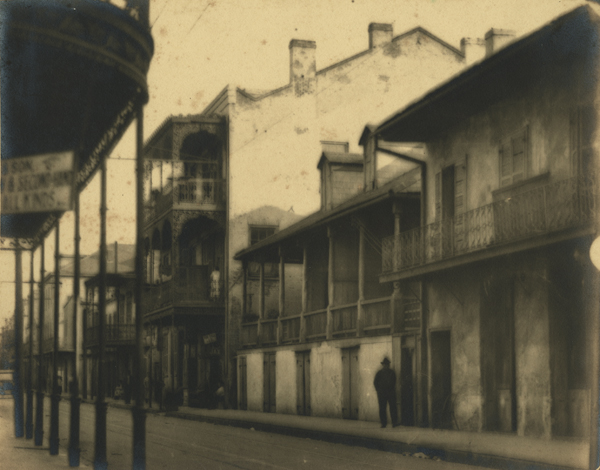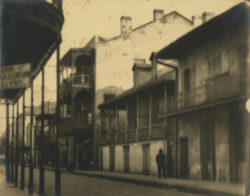Historic Preservation
New Orleans's French Quarter was an early testing ground for preservation measures, and it continues to be one today.

Courtesy of State Library of Louisiana
Street in the New Orleans French Quarter. Whitesell, Joseph Woodson (Photographer)
More than twenty million people visited Louisiana in the year 2000 and around eleven million were drawn to New Orleans, three-quarters of them for pleasure. With a resident population at that time of approximately 485,000, it was no wonder that the city relied heavily on revenues from tourism. While the immediate impact of hurricanes Katrina and Rita in 2005 significantly reduced the New Orleans’ resident population and the numbers of tourists, by 2010, both had experienced notable growth. Thus, the concern remains that commercial tourism will stamp out the historic authenticity it seeks.
New Orleans’s Vieux Carré (or French Quarter) was an early testing ground for preservation measures, and it continues to be one. In the early twentieth century, politicians and real estate interests saw the Vieux Carré’s aging structures as candidates for demolition. For others — writers, artists, and a few influential socialites — the decay was picturesque and the buildings historically significant. It was this mix of people who decided to seek legal mechanisms to protect the Vieux Carré and its residential character. The Vieux Carré Association, formed in 1926, evolved in 1936 into the Vieux Carré Commission (VCC), whose charge was to preserve the neighborhood’s traditional architecture and its living, diverse character by setting guidelines for design and renovation.
The Vieux Carré’s residents and the commission have achieved some notable successes, particularly in helping defeat a proposal in 1958 for an elevated expressway bordering the river in front of Jackson Square. Although the VCC initially approved the scheme, citizens’ pressure and the local chapter of he American Institute of Architects forced the Commission to reverse its decision in 1963, a decision that convinced the federal Department of Transportation to cancel the project in 1969. Among the challenges facing the VCC is maintaining the residential qualities of the area despite the numbers of tourists, conventioneers, and time-share rentals, which foster a “theme-park” atmosphere. The banning of large tourist buses in the Quarter was a victory for the VCC. Vibrations from the weight and engines of these buses were destabilizing the very buildings the tourists want to see. Large tourist buses are also prohibited from entering New Orleans’ Garden District, an up-scale historic residential area that also attracts many tourists.
At the state level, Louisiana’s Department of Culture, Recreation and Tourism in Baton Rouge is the umbrella office for a variety of divisions concerned with historic preservation. These include the Division of Archaeology and the Division of Historic Preservation (SHPO). The latter administers such programs as listing on the National Register of Historic Places, and the Main Street Program of the National Trust for Historic Preservation, which helps downtown areas capitalize on their historic buildings. As of 2010, 35 towns participate in this program. The Division also administers the Federal Historic Preservation Tax Credit program that was introduced in 1976 to nurture preservation and discourage demolition. In Louisiana, these tax breaks have been instrumental in saving such areas as New Orleans’s historic warehouse district, which has been converted from an abandoned downtown section of the city into a vital residential neighborhood. SHPO’s role and work in the rehabilitation and preservation of buildings expanded enormously after hurricanes Katrina and Rita.
Aiding in building preservation and accurate restoration is the detailed information about Louisiana’s historically significant structures that continues to be recorded for the Historic American Building Survey (HABS). Established in 1933 and administered by the National Park Service, the measured drawings, photographs, and written documentation are preserved at the Library of Congress in Washington, D.C. Fortunately for Louisiana, in 1933 HABS hired architect Richard Koch as the state’s first district officer. As a partner in the architecture firm of Armstrong and Koch, he was involved in the restorations of Shadows-on-the-Teche and Oak Alley plantations (1922 and 1926, respectively), as well as projects within the Vieux Carré. The buildings Koch photographed during this period form an invaluable record of the state’s high-style and vernacular architecture. Louisiana’s HABS drawings are now mostly undertaken by architecture students under the supervision of university faculty from Louisiana’s architecture schools.
Louisiana’s historic engineering and industrial structures are documented for the Historic American Engineering Record (HAER), which was established in 1969, and its landscapes for the Historic American Landscapes Survey (HALS), founded in the year 2000. HAER and HALS records also are preserved at the Library of Congress. Richard Koch’s passion for Louisiana’s architecture was inherited by his associate Samuel Wilson, Jr., whose research in the notarial archives in New Orleans and in archives in France uncovered the history of many of Louisiana’s earliest buildings.
One consequence of the Vieux Carré expressway controversy was a new public awareness of the state’s historic treasures. In the second half of the twentieth century, Louisiana’s citizens began to form organizations and to initiate programs dedicated to preservation. The Louisiana Landmarks Society, founded in 1950, primarily focuses on individual buildings and lobbies for the preservation of threatened structures. The society also maintains the Pitot House, one of New Orleans’s oldest houses. Other statewide organizations include the Foundation for Historical Louisiana established in 1963 and the Louisiana Preservation Alliance, formed in 1979, which in the 1990s prepared a comprehensive preservation plan for the Mississippi River Road corridor.
Other groups are devising programs specific to their communities. In Lake Charles, preservationists began Heritage Awareness tours of the city’s historic downtown residential areas, which successfully attracted a younger generation to purchase homes there. The Shreveport Historic Preservation Society was created in 2007. Save our Cemeteries, founded in New Orleans 1974 to prevent demolition of wall vaults in St. Louis Cemetery No. 2, is involved in protecting all of the city’s unique above-ground tombs as well as those in historic cemeteries beyond the city. A city agency, the Historic District Landmarks Commission, was set up in 1976 to oversee the visual quality of New Orleans’ buildings and regulate restoration and demolition.
New Orleans’s Preservation Resource Center (PRC), a non-profit organization incorporated in 1974, can count many significant achievements in the city. It purchased, renovated and in 1981 established its offices in a row built in 1832 on then-decaying Julia Street, thus taking what proved to be the first step in a revitalization of the Central Business District. And in response to Louisiana’s 1980s economic recession, which accelerated depopulation and blight, the PRC initiated several programs, among them enlisting the services of volunteers every October to repair and paint houses for homeowners in need of assistance. As almost all New Orleans’s houses are constructed of wood, continual maintenance is an essential tool of preservation. The PRC also selected the Lower Garden District for special attention. By the late 1980s, this 24-block area of formerly upscale historic houses had more than one hundred severely blighted buildings; owner occupancy in the area was less than 28 percent, and 60 properties were vacant. A program to provide interim funding for the acquisition and renovation of vacant houses to pre-qualified home buyers has had considerable success and motivated resident involvement in the community.
Historic plantations are among Louisiana’s most popular tourist attractions. In the late twentieth century they received preservation money from an unexpected source—the oil and chemical companies along the Mississippi River that would once have simply demolished them. Dow Chemical moved the Aillet House from land it acquired in West Baton Rouge Parish and restored it in a new location at the West Baton Rouge Museum. Marathon Oil gave financial assistance for the restoration of San Francisco plantation, and Shell Oil continues to restore Ashland Belle-Helene. Other industrial companies are following suit in lending some of their economic clout to the preservation effort. Yet much more needs to be done.
The preservation of Louisiana’s unique natural landscape and wildlife is also urgent. Even before hurricanes Katrina and Rita, the state was losing between 25 and 35 square miles of coastal wetlands each year. The causes included storm damage, rising sea levels, subsidence, floods, and such human alterations as oil and gas exploration, navigation canals, flood-control levees, and urban expansion. The Coastal Wetlands Planning, Protection and Restoration Act of 1990 was an important step in addressing the problem. But the hurricanes of 2005 undid much of its work and the BP oil spill of 2010 created a new set of problems that has yet to be fully understood.
In the late twentieth and early twenty-first centuries, preservation efforts in Louisiana began to broaden their scope. For example, the focus on the plantation house and its elite society expanded to an understanding of the entire built complex of the plantation and its community. Founded in 2005, the Louisiana branch of DOCOMOMO focuses on the preservation of buildings from the second half of the twentieth century, but this is not yet a high priority in a state with such a rich and revered more distant past.
Adapted from Karen Kingsley’s Buildings of Louisiana, part of the Buildings of the United States series commissioned by the Society of Architectural Historians (www.sah.org) and published by Oxford University Press.
